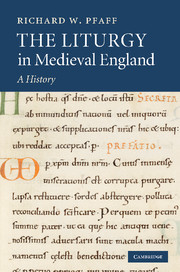Book contents
- Frontmatter
- Contents
- Preface
- Sigla and editorial conventions
- Bibliographical abbreviations
- Nicknames for manuscripts frequently referred to
- 1 Introduction
- Excursus: on sources
- 2 Early Anglo-Saxon England: a partly traceable story
- Excursus: on the terms Gregorian and Gelasian as used here
- 3 Later Anglo-Saxon: liturgy for England
- 4 The Norman Conquest: cross fertilizations
- Excursus: on method in the comparison of liturgical texts
- 5 Monastic liturgy, 1100–1215
- Excursus: on ascription of liturgical books to specific churches
- 6 Benedictine liturgy after 1215
- 7 Other monastic orders
- 8 The non-monastic religious orders: canons regular
- 9 The non-monastic religious orders: friars
- Excursus: on liturgical books from female religious houses
- 10 Old Sarum: the beginnings of Sarum Use
- 11 New Sarum and the spread of Sarum Use
- 12 Exeter: the fullness of secular liturgy
- 13 Southern England: final Sarum Use
- 14 Regional Uses and local variety
- 15 Towards the end of the story
- Index of Manuscripts
- Index of Saints
- General Index
15 - Towards the end of the story
Published online by Cambridge University Press: 20 March 2010
- Frontmatter
- Contents
- Preface
- Sigla and editorial conventions
- Bibliographical abbreviations
- Nicknames for manuscripts frequently referred to
- 1 Introduction
- Excursus: on sources
- 2 Early Anglo-Saxon England: a partly traceable story
- Excursus: on the terms Gregorian and Gelasian as used here
- 3 Later Anglo-Saxon: liturgy for England
- 4 The Norman Conquest: cross fertilizations
- Excursus: on method in the comparison of liturgical texts
- 5 Monastic liturgy, 1100–1215
- Excursus: on ascription of liturgical books to specific churches
- 6 Benedictine liturgy after 1215
- 7 Other monastic orders
- 8 The non-monastic religious orders: canons regular
- 9 The non-monastic religious orders: friars
- Excursus: on liturgical books from female religious houses
- 10 Old Sarum: the beginnings of Sarum Use
- 11 New Sarum and the spread of Sarum Use
- 12 Exeter: the fullness of secular liturgy
- 13 Southern England: final Sarum Use
- 14 Regional Uses and local variety
- 15 Towards the end of the story
- Index of Manuscripts
- Index of Saints
- General Index
Summary
For the hundred years or so with which this book must conclude there is a vast amount of material, more than can be taken in and used effectively. The difficulty is one of selection: the opposite of that with the earliest periods, where we had to squeeze the few available sources for every possible drop of inference. Despite, or perhaps because of, this plethora of material, the ground is potentially tricky here. In general, any mention of the close, or end, of the middle ages conjures what in conventional periodization comes “next,” the (note the definite article) Reformation. The difficulty here is not partisanship – happily, no longer the bugbear of dispassionate investigation – but the implicit teleology of which we have been steadily aware (often mentioned, from p. 9 on). Even recognizing the temptation, we may find it hard when talking about liturgy in the late fifteenth and early sixteenth centuries to avoid attitudes expressed in metaphorical language like “autumn” and “tiredness” – and, these days, even harder to avoid those that suggest “freshness” and “vitality.” The cogency of the argument for each pair of nouns will be examined briefly at the end of this chapter; we need to begin it by going back earlier in the fifteenth century, to the founding of a new religious order in England, the Bridgettines.
The Bridgettines
The religious establishment with the simplest, and at the same time most paradoxical, character in our story is that of the Ordo sanctissimi Salvatoris, usually known as Bridgettines, whose English presence began in 1415 at the instigation of king Henry V.
Information
- Type
- Chapter
- Information
- The Liturgy in Medieval EnglandA History, pp. 529 - 555Publisher: Cambridge University PressPrint publication year: 2009
